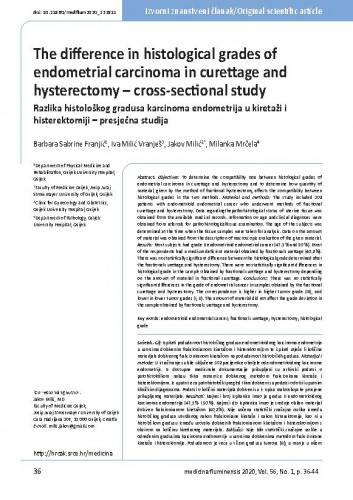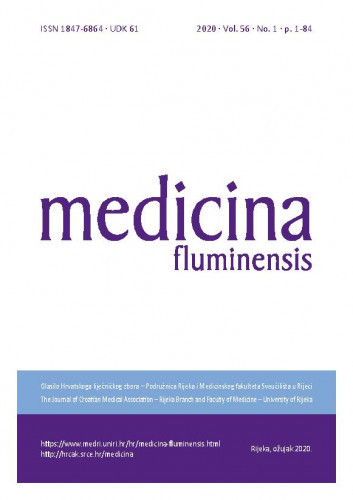Objectives: To determine the compatibility rate between histological grades of endometrial carcinoma in curettage and hysterectomy and to determine how quantity of material, given by the method of fractional hysterectomy, affects the compatibility between histological grades in the two methods. Material and methods: The study included 102 patients with endometrioid endometrial cancer who underwent methods of fractional curettage and hysterectomy. Data regardingthepathohistological status of uterine tissue was obtained from the available medical records. Information on age andclinical diagnoses were obtained from referrals for pathohistologicaltissue examination. The age of the subjects was determined at the time when the tissue samples were taken for analysis. Data on the amount of material was obtained from the description of macroscopic evaluation of the given material. Results: Most subjects had grade II endometrioid endometrial cancer (47.1 % and 50 %). Most of the respondents had a medium deficient material obtained by fractional curettage (40.2 %). There was no statistically significant difference between the histological grade determined after the fractional curettage and hysterectomy. There were no statistically significant differences in histological grade in the sample obtained by fractional curettage and hysterectomy depending on the amount of material in fractional curettage. Conclusions: There was no statistically significant differences in the grade of endometrial cancer in samples obtained by the fractional curettage and hysterectomy. The correspondence is higher in higher tumor grade (III), and lower in lower tumor grades (I, II). The amount of material did not affect the grade deviation in the sample obtained by fractional curettage and hysterectomy.; Cilj: Ispitati podudarnost histološkog gradusa endometrioidnog karcinoma endometrija u uzorcima dobivenim frakcioniranom kiretažom i histerektomijom te ispitati utječe li količina materijala dobivenog frakcioniranom kiretažom na podudarnost histoloških gradusa. Materijal i metode: U istraživanje su bile uključene 102 pacijentice oboljele od endometrioidnog karcinoma endometrija. Iz dostupne medicinske dokumentacije prikupljeni su arhivski podatci o patohistološkom nalazu tkiva maternice dobivenog metodom frakcionirane kiretaže i histerektomijom. Iz uputnice za patohistološki pregled tkiva dobiveni su podatci o dobi i uputnim kliničkim dijagnozama. Podatci o količini materijala dobiveni su iz opisa makroskopske procjene prikupljenog materijala. Rezultati: Najveći broj ispitanica imao je gradus II endometrioidnog karcinoma endometrija (47,1 % i 50 %). Najveći dio ispitanica imao je srednje obilan materijal dobiven frakcioniranom kiretažom (40,2 %). Nije uočena statistički značajna razlika između histološkog gradusa utvrđenog nakon frakcionirane kiretaže i nakon histerektomije, kao ni u histološkom gradusu između uzoraka dobivenih frakcioniranom kiretažom i histerektomijom s obzirom na količinu kiretiranog materijala. Zaključci: Nije bilo statistički značajne razlike u određenim gradusima karcinoma endometrija u uzorcima dobivenima metodom frakcionirane kiretaže i histerektomije. Podudarnost je veća u višem gradusu tumora (III), a manja u nižem gradusu tumora (I, II). Količina materijala nije utjecala na odstupanje gradusa u uzorku dobivenom frakcioniranom kiretažom i histerektomijom.
Sažetak
Dio od

 Medicina Fluminensis : glasilo Hrvatskog liječničkog zbora - Podružnica Rijeka i Medicinskog fakulteta Sveučilišta u Rijeci = the journal of Croatian Medical Association - Rijeka Branch and Faculty of Medicine - University of Rijeka : 56,1(2020) / glavni i odgovorni urednik, editor-in-chief Saša Ostojić.
Medicina Fluminensis : glasilo Hrvatskog liječničkog zbora - Podružnica Rijeka i Medicinskog fakulteta Sveučilišta u Rijeci = the journal of Croatian Medical Association - Rijeka Branch and Faculty of Medicine - University of Rijeka : 56,1(2020) / glavni i odgovorni urednik, editor-in-chief Saša Ostojić.